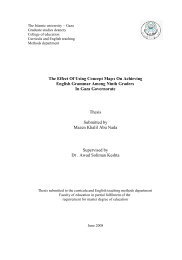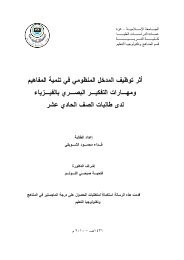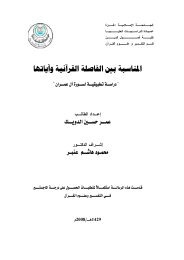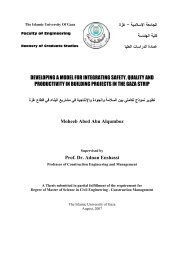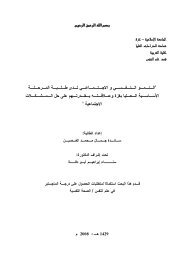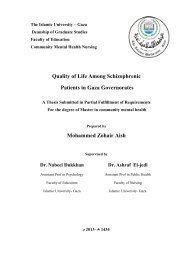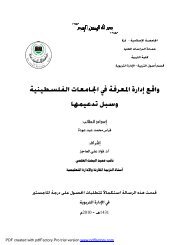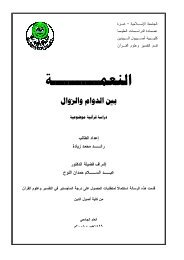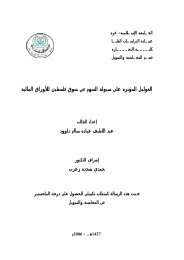A Study of Lean Construction Practices in Gaza Strip
A Study of Lean Construction Practices in Gaza Strip
A Study of Lean Construction Practices in Gaza Strip
Create successful ePaper yourself
Turn your PDF publications into a flip-book with our unique Google optimized e-Paper software.
2.5.6 Increase output flexibility<br />
Flexibility should be limited dur<strong>in</strong>g the period <strong>of</strong> construction. We can talk about it<br />
from the duration <strong>of</strong> the project, for example, by us<strong>in</strong>g standardization <strong>of</strong> works, we can<br />
add the number <strong>of</strong> resources to reduce the time, while the change <strong>in</strong> the activity affects<br />
the project.<br />
2.5.7 Increase process transparency<br />
In a theoretical sense, transparency means a separation <strong>of</strong> the network <strong>of</strong> <strong>in</strong>formation<br />
and the hierarchical structure <strong>of</strong> order giv<strong>in</strong>g, which <strong>in</strong> the classical organization theory<br />
are identical. The goal is thus to substitute self-control for formal control and related<br />
<strong>in</strong>formation gather<strong>in</strong>g.<br />
Transparency reduces errors and <strong>in</strong>creases motivation for improvement. Thus, it is an<br />
objective to make the production process transparent and observable for facilitation <strong>of</strong><br />
control and improvement: “to make the ma<strong>in</strong> flow <strong>of</strong> operations from start to f<strong>in</strong>ish<br />
visible and comprehensible to all employees” (Stalk and Hout 1989). This can be<br />
achieved by mak<strong>in</strong>g the process directly observable through organizational or physical<br />
means, measurements, and public display <strong>of</strong> <strong>in</strong>formation.<br />
Practical approaches for enhanced transparency <strong>in</strong>clude the follow<strong>in</strong>g:<br />
� Establish<strong>in</strong>g basic housekeep<strong>in</strong>g to elim<strong>in</strong>ate clutter.<br />
� Mak<strong>in</strong>g the process directly observable through appropriate layout and signage<br />
� Render<strong>in</strong>g <strong>in</strong>visible attributes <strong>of</strong> the process visible through measurements<br />
� Embody<strong>in</strong>g process <strong>in</strong>formation <strong>in</strong> work areas, tools, conta<strong>in</strong>ers, materials and<br />
<strong>in</strong>formation systems<br />
� Utiliz<strong>in</strong>g visual controls to enable any person to immediately recognize<br />
standards and deviations from them.<br />
� Reduc<strong>in</strong>g the <strong>in</strong>terdependence <strong>of</strong> production units (focused factories).<br />
2.5.8 Focus control on the complete process<br />
There are two causes <strong>of</strong> segmented flow control: the flow traverses different units <strong>in</strong> a<br />
hierarchical organization or crosses through an organizational border. In both cases,<br />
there is a risk <strong>of</strong> sub optimization.<br />
There are at least two prerequisites for focus<strong>in</strong>g control on complete processes. First,<br />
the complete process has to be measured. Secondly, there must a controll<strong>in</strong>g authority<br />
for the complete process. Several alternatives are currently used. In hierarchical<br />
12





